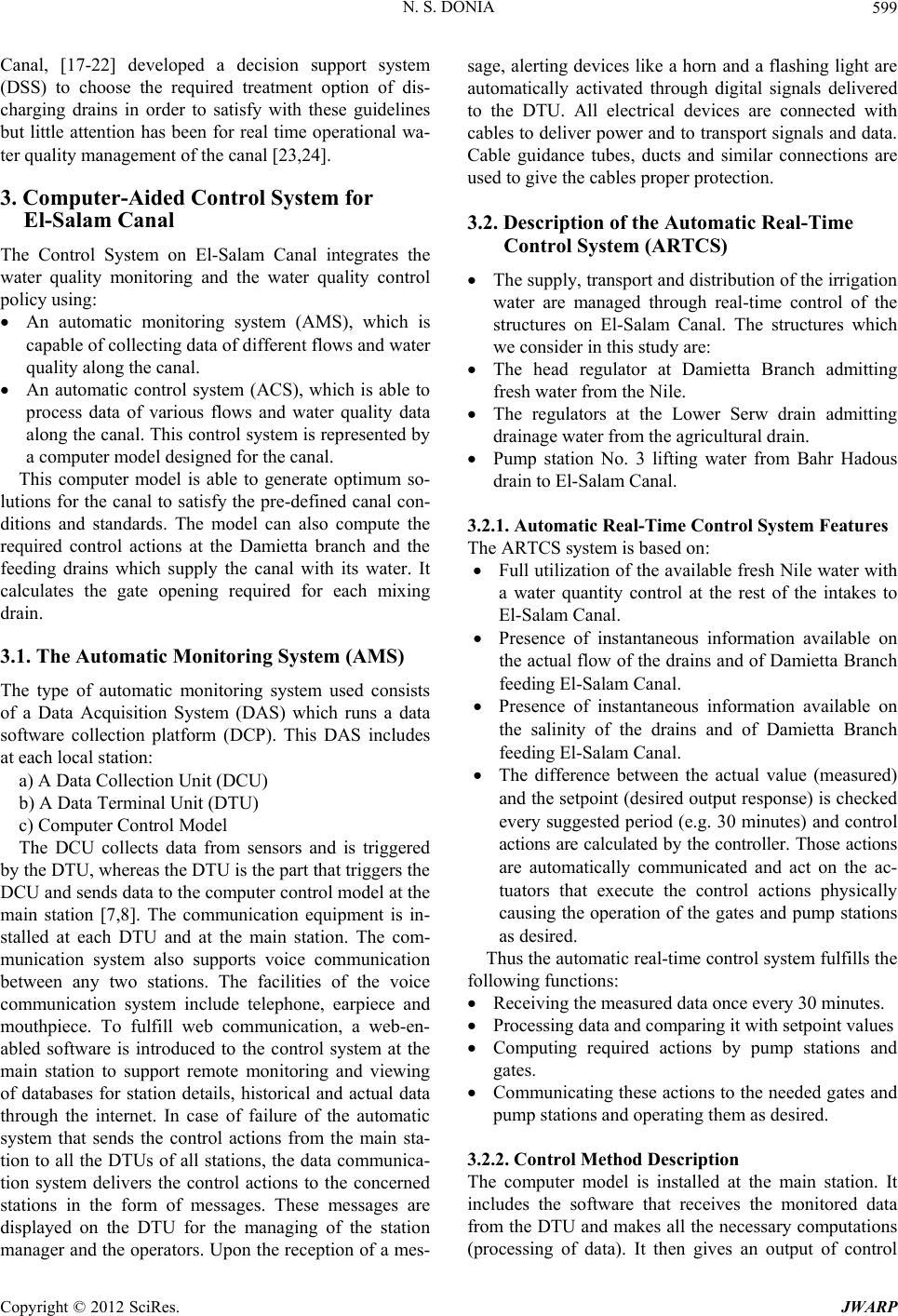
N. S. DONIA 599
Canal, [17-22] developed a decision support system
(DSS) to choose the required treatment option of dis-
charging drains in order to satisfy with these guidelines
but little attention has been for real time operational wa-
ter quality management of the canal [23,24].
3. Computer-Aided Control System for
El-Salam Canal
The Control System on El-Salam Canal integrates the
water quality monitoring and the water quality control
policy using:
An automatic monitoring system (AMS), which is
capable of collecting data of different flows and water
quality along the can a l.
An automatic control system (ACS), which is able to
process data of various flows and water quality data
along the canal. Th is control system is represented by
a computer model designed for the canal.
This computer model is able to generate optimum so-
lutions for the canal to satisfy the pre-defined canal con-
ditions and standards. The model can also compute the
required control actions at the Damietta branch and the
feeding drains which supply the canal with its water. It
calculates the gate opening required for each mixing
drain.
3.1. The Automatic Monitoring System (AMS)
The type of automatic monitoring system used consists
of a Data Acquisition System (DAS) which runs a data
software collection platform (DCP). This DAS includes
at each local station:
a) A Data Collection Unit (DCU)
b) A Data Terminal Unit (DTU)
c) Computer Control Model
The DCU collects data from sensors and is triggered
by the DTU, whereas the DTU is the part that triggers the
DCU and sends data to the computer control model at the
main station [7,8]. The communication equipment is in-
stalled at each DTU and at the main station. The com-
munication system also supports voice communication
between any two stations. The facilities of the voice
communication system include telephone, earpiece and
mouthpiece. To fulfill web communication, a web-en-
abled software is introduced to the control system at the
main station to support remote monitoring and viewing
of databases for station details, historical and actual data
through the internet. In case of failure of the automatic
system that sends the control actions from the main sta-
tion to all the DTUs of all stations, the data communica-
tion system delivers the control actions to the concerned
stations in the form of messages. These messages are
displayed on the DTU for the managing of the station
manager and the operators. Upon the reception of a mes-
sage, alerting devices like a horn and a flashing light are
automatically activated through digital signals delivered
to the DTU. All electrical devices are connected with
cables to deliver power and to transport sign als and data.
Cable guidance tubes, ducts and similar connections are
used to give the cables proper protection.
3.2. Description of the Automatic Real-Time
Control System (ARTCS)
The supply, transport and distribution of the irrigation
water are managed through real-time control of the
structures on El-Salam Canal. The structures which
we consider in this study are:
The head regulator at Damietta Branch admitting
fresh water from the Nile.
The regulators at the Lower Serw drain admitting
drainage water from the agricultural drain.
Pump station No. 3 lifting water from Bahr Hadous
drain to El-Salam Canal.
3.2.1. Automatic Real-Time Control System Featur es
The ARTCS s ystem i s based on :
Full utilization of th e available fresh Nile water with
a water quantity control at the rest of the intakes to
El-Salam Canal.
Presence of instantaneous information available on
the actual flow of the drains and of Damietta Branch
feeding El-Salam Canal.
Presence of instantaneous information available on
the salinity of the drains and of Damietta Branch
feeding El-Salam Canal.
The difference between the actual value (measured)
and the setpoint (desired output response) is checked
every suggested period (e.g. 30 minutes) and control
actions are calculated by the controller. Those actions
are automatically communicated and act on the ac-
tuators that execute the control actions physically
causing the operation of the gates and pump stations
as desired.
Thus the automatic real-time contro l system fulfills the
following functions:
Receiving the measured data once every 30 minutes.
Processing data and comparing it with setpoint values
Computing required actions by pump stations and
gates.
Communicating these actions to the needed gates and
pump stations and operating them as desired.
3.2.2. Control Met h od Description
The computer model is installed at the main station. It
includes the software that receives the monitored data
from the DTU and makes all the necessary computations
(processing of data). It then gives an output of control
Copyright © 2012 SciRes. JWARP